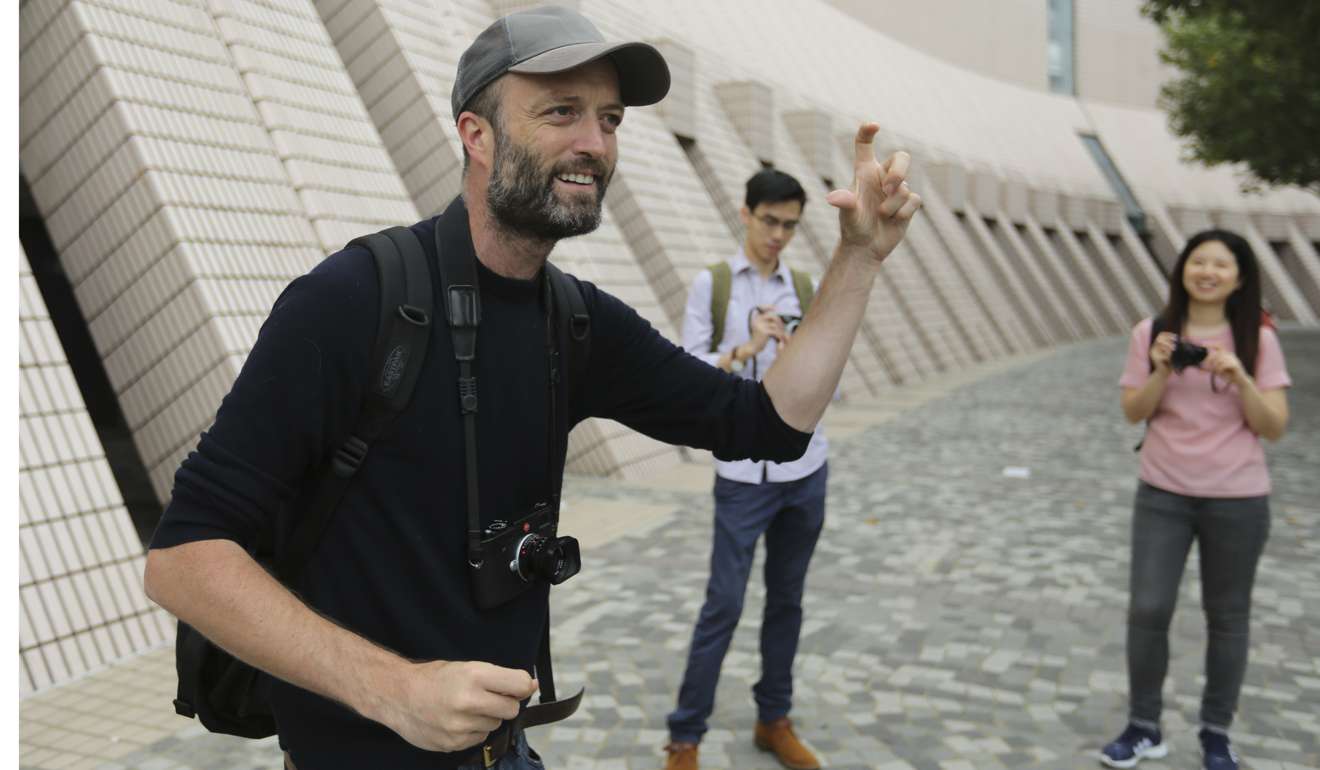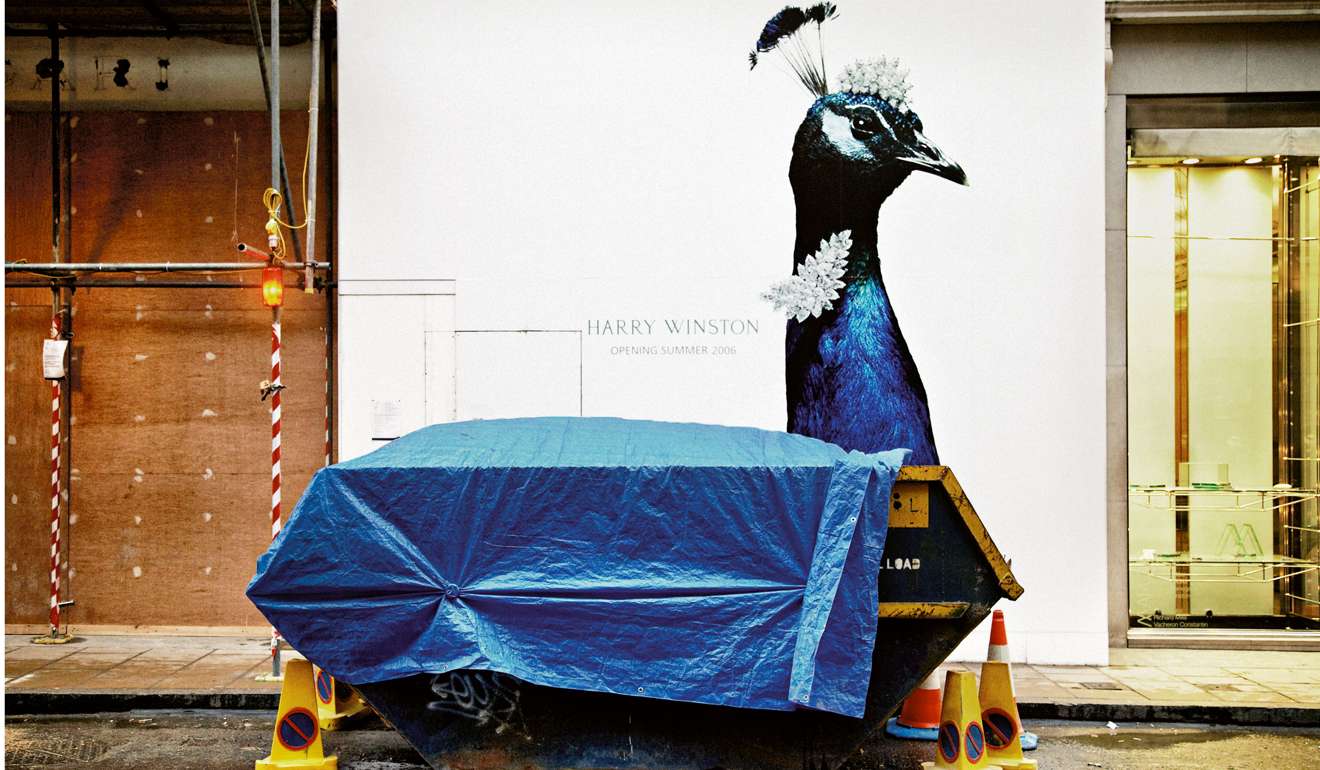
How to get the best out of Hong Kong’s streets for your photos: a Magnum nominee’s advice
Delivering a workshop in Hong Kong, London-based Magnum nominee Matt Stuart says luck can produce a striking shot, but persistence, watchfulness and speed are essential
London-based street photographer Matt Stuart doesn’t like posing for pictures but he’s game to ham it up for our photographer at the Hong Kong Cultural Centre, where angled, pink-tiled pillars create triangular shadows.
Posed photos aren’t what Stuart is known for – his are based on chance, perfect timing and being fast. They are quirky and light-hearted: a man walking down a street holds a walking stick to his face with the handle looking like a joke nose; a large dog appears to be sitting in the front seat of a car; a man stands near an ad depicting a giant pointing finger.
Having taken photos for 20 years and published a book called All That Life Can Afford, Stuart has become a Magnum Photos nominee, meaning his work will be assessed over a two-year period, and he could eventually become a member of the prestigious photography association.
He was recently in Hong Kong to host a three-day workshop on street photography for Magnum, which celebrates its 70th anniversary this year. His 15 students, paying more than HK$5,000, came from places including France, Singapore, Myanmar and Hong Kong, and were mostly amateurs.

As the group spreads out around the Tsim Sha Tsui Star Ferry pier and Cultural Centre, Stuart gives them one-on-one help, nudges them to get closer to their subject, reminds them to keep their elbows in, or gives pointers on where to stand, and even suggests what to shoot.
“Look at those two women,” he says, pointing to two Caucasian women about 15 metres away, wearing striped tops and khakis. “They must have asked each other what they were wearing and decided to do the same.”
He urges one student to get closer and quickly take a photo as they smoke cigarettes, but it was too late – they walked off.
A new perspective: 10 years as a domestic helper in Hong Kong, now a globe-trotting photographer
“If there’s one word that sums it all up, it’s time. I spend a lot of time walking around and looking. It’s about taking the picture at the right time,” he says a few days earlier after arriving from Las Vegas, where he’d wandered around for a week. Sin City may seem like fertile ground for street photography, but Stuart didn’t think so.
“It’s tricky to photograph. It’s like going to Disneyland and it’s a kind of contrived, weird and wonderful,” he explains. “It’s almost too obvious.”

It’s real life that inspires him, and Stuart enjoys teaching others how to take photos. He feeds off their enthusiasm. His reward is seeing them improve in a short period of time.
“Years ago I did a workshop with Magnum photographer Leonard Freed [who died in 2006] and I got to watch him work, and that’s the best learning device.”
Within a few hours of landing in Hong Kong, Stuart had already noticed the city’s busy pace, its mass of colour and visual noise.
“Different countries have different ways of dealing with photography,” he says. “For example, in New York, Fifth Avenue, it’s like an escalator with people coming at you in one direction, whereas I expect here people are more crossing and changing direction in a grid system.”
‘Afghan Girl’ photographer Steve McCurry on portraits that capture humanity
A good way to increase the chance of getting a good shot, Stuart says, is standing at the corner of an intersection – facing away from the traffic. “That way you have people coming from two different angles. It’s almost impossible to capture a collision. People collide very rarely.”
He says there are three ways to get good street photos. “First is to follow. Find someone who’s interesting and just stick with them and shoot what’s happening. Next is you fish, or stay in one place … and wait for people to walk into your shot. The third is ‘f***!’, because it happens right in front of you and you have to be prepared and ready. They are generally the best ones.”

There’s an image Stuart took of a Harry Winston ad of a peacock head wearing diamond jewellery, and a skip on the street wrapped in a tarp matching the bird’s blue shade looks like its body.
Being a good street photographer means training yourself to see in a certain way, he says. “You have to have time to look … being in a public place with no agenda gives you time to observe things thoroughly. Time could be two to three hours or the whole day; it’s time not doing other stuff.”
Walking around all day snapping photos can be meditative when there’s no agenda, no destination, he says. “You just clear your brain of distractions and focus on the now … and I can keep on sounding like a hippy if you want me to, but it’s true,” he jokes.
Hong Kong-based photographer focuses on city’s beloved ‘ding dings’
During the workshop, he advises students to be discreet and wear low-key clothing. He’s in a navy blue sweater, jeans, trainers and a baseball cap. Then you have to be fast.
He suggests trying to get as close to the subject, quickly, but without rushing up to them so that they notice. Take the shot and leave just as quickly.
Since he’s out every day keenly observing people, he notices different types of body language.
“There are people who are quite lost, looking around at their map or phone to figure out where they are. Then there are people who are lost, on their mobile, phone covering their mouth, feeling insecure. And then the most interesting are those who are really lost and find a corner and face into it. It’s an animal instinct.”

Stuart may have felt lost when it came to figuring out what to do as a “grown up”. A high school dropout from the suburb of Harrow, northwest London, Stuart was a skateboarder “extraordinaire” who earned sponsorships. He also dabbled in kung fu.
“But then at 20, I fell in love with a woman – what a mistake – and gave up skateboarding,” he says, adding that he thought he’d have to grow out of his street antics.
Snap! Magnum street photographer Richard Kalvar returns to Hong Kong
In about 1996, he got a job answering customer complaints at Vodafone, which he describes as soul-destroying. His father gave him books of photographs by Henri Cartier-Bresson and Robert Frank, and as customers complained down the phone, for two years Stuart flipped through the books, falling in love with the photos.
Inspired, Stuart bought a Leica camera and became a third assistant for a commercial photographer. One of his tasks was delivering pictures to clients. “It was a great excuse to be out so I took lots of pictures on the Tube.” He worked his way up to second and then first assistant, and after three years, in 2000, he decided to go it alone.
“We can all take good photographs,” he says, and with smartphones, that means there are billions of photos in the ether, but only a few good ones.

Nevertheless, social media, particularly Instagram, is great platform for photographers, he says. “Most great photographers use Instagram. They can share their picture with 24,000 people in 24 hours, as opposed to 240 people looking at it in a gallery. It makes photography more accessible to people.”
One of the Hong Kong workshop students, Johnalene Baylon, follows Magnum Photos on Instagram, which is how she learned about Stuart’s course. A digital marketing executive, she has dabbled in photography for about a year. Speaking on the second day of the workshop, she says she has learned a lot.
“He teaches us how to see and what to look for, and learn how to be confident to get up close,” she says. “It’s only after we finish shooting that I go through the images and find some that might work after editing. I should keep shooting, but not blindly.”
How Angkor Photo Festival became Southeast Asia’s top event for aspiring photographers
Another student, Alex De Chazal, is a hobby photographer whose day job is in banking. Dressed in jeans and a dark top, De Chazal is excited about the opportunity to learn from Stuart, whose work he follows.
“Street photography is a good base to have, a good starting point,” he says. “So far, so good.”
Asked about the difference between male and female photographers, Stuart says that, broadly, from his workshops, he sees that women see colour better and embrace it more than men, and are more open to experimentation.
But in the end, good photography boils down to one thing. “How much do you want to take a great picture?” he asks. “I spend a lot of time trying to get perfect pictures, and very rarely does that happen.”

